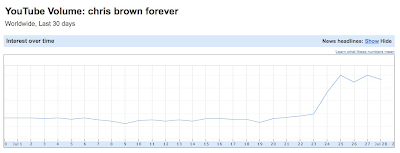Last week the world watched in wonder as Jill Peterson and Kevin Heinz's wedding party transformed a familiar and predictable tradition into something spontaneous and just flat-out fun. The video, set to R&B star Chris Brown's hypnotic dance jam "Forever," became an overnight sensation, accumulating more than 10 million views on YouTube in less than one week. But as with all great YouTube videos, there's more to this story than simple view counts.
At YouTube, we have sophisticated content management tools in place to help rights holders control their content on our site. The rights holders for "Forever" used these tools to claim and monetize the song, as well as to start running Click-to-Buy links over the video, giving viewers the opportunity to purchase the music track on Amazon and iTunes. As a result, the rights holders were able to capitalize on the massive wave of popularity generated by "JK Wedding Entrance Dance" — in the last week, searches for "Chris Brown Forever" on YouTube have skyrocketed, making it one of the most popular queries on the site:

This traffic is also very engaged — the click-through rate (CTR) on the "JK Wedding Entrance" video is 2x the average of other Click-to-Buy overlays on the site. And this newfound interest in downloading "Forever" goes beyond the viral video itself: "JK Wedding Entrance" also appears to have influenced the official "Forever" music video, which saw its Click-to-Buy CTR increase by 2.5x in the last week.
So, what does all of this mean? Despite compelling data and studies around consumer purchasing habits, many still question the promotional and bottom-line business value sites like YouTube provide artists. But in the last week, over a year after its release, Chris Brown's "Forever" has again rocketed up the charts, reaching as high as #4 on the iTunes singles chart and #3 on Amazon's best selling MP3 list. We've seen similar successes in the past with partners like Monty Python.
One of our main goals at YouTube is to help content creators effectively make money from the distribution of their content online. That they can do so in a way that brings artists and our community together to create fun, spontaneous and inspiring works, is one of the best and most exciting things about YouTube.






















.png)






